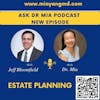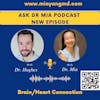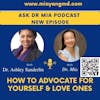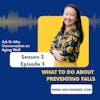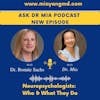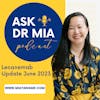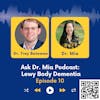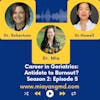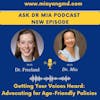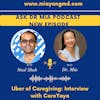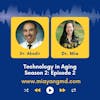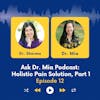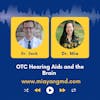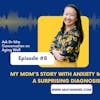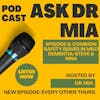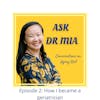Microboosts to Feel Better: Holistic Pain Solutions with Dr. Saloni Sharma, Part 1

Dr. Mia talks with Dr. Sharma, dual board-certified in physical medicine & rehabilitation and pain management, about holistic pain solutions based on the 5R's in Dr. Sharma's book The Pain Solution: refuel (food), revitalize (exercise), recharge (sleep), refresh (meditation/mindset), and relate (social connections). This part 1 talks about the first 3 R's: refuel, revitalize, and recharge.
More info on Dr. Saloni Sharma
Johns Hopkins' Chair Yoga exercises
Kaiser Permanente meditation resources
NIA's short exercises for older adults on YouTube
Music & disclaimer
Transcripts on www.miayangmd.com.
Email: ask@miayangmd.com
Opinions expressed are exclusive of Dr. Mia Yang and not reflective of her or guest speaker's employers or funders.
Dr. Mia Yang 00:37
Welcome to ask Dr. Mia podcast. Today I have a special guest, Dr. Saloni Sharma with me. I'm gonna let Dr. Sharma introduce herself and tell us about what she does.
Dr. Saloni Sharma 00:50
Hi, Dr. Mia, thanks for having me on your podcast. I'm really happy to be here and talk about aging well. I'm the Medical Director of the Orthopedic Integrative Health Center in Philadelphia and I've also written a book called The Pain solution. It's really an anti-inflammatory approach to living and aging well. So I think this will be a great overlap of our interests and ways to serve our audience.
Dr. Mia Yang 01:08
Absolutely, Dr. Sharma, tell me about what inspired you to write this book? and what are some major key messages that you want the audience to understand?
Dr. Saloni Sharma 01:20
I really have a pain crisis. I think we all know we have an opioid crisis because we have a pain crisis. As we were talking about before the recording started, we tell people, as physicians, as healthcare providers, don't use narcotic medications, don't use anti inflammatories, but then we don't tell them what to do instead. So there's a big void, what should you do instead? So hopefully, that's some of what the book does. Our discussion today is that there's lots of things you can do instead, to lower your overall pain. And it starts with lowering your overall inflammation level on your body, which, as you've mentioned, in your other podcasts can contribute to these conditions like dementia and other age related diseases like heart disease as well. So we can reduce inflammation. It's not only good for pain, it's good for whole body health.
Dr. Mia Yang 01:58
Yeah, absolutely. I think the people who are listening to this podcast are interested and they're proactive about their health, whether it's for themselves or for their loved ones who are older. I think I see it a lot in my clinical practice as well, where I have a lot of older adults who have chronic pain, chronic back ,knee, joint pain, and we are hesitant to give them anti inflammatory medications like ibuprofen, aleve, because of potential side effects in leading risks, but we can only give so much Tylenol before people say, well, Tylenol doesn't work. Then we get stuck in thinking, should we? Or should we not start with opioids? Of course, all of the side effects that go with starting an opioid for chronic pain, just as you said, there is a gap in what people can do to help with their pain and take a proactive approach to their pain. So tell me about the book and the five steps to relieve and purvey back, muscle, and joint pain.
Dr. Saloni Sharma 03:06
Sure,so I think sort of expanding on what you said too, before we jump right into it. There's healthspan and there's lifespan. I don't know how familiar the audiences are with those subjects. Lifespan is the number of years we live. So you know, how do you live, but healthspan is the number of years you live in good health. In the United States, the average gap between healthspan and lifespan is 16 years. So it's those last 16 years, which is something a lot of your patients that you work with that you see day to day, but that's what we want to increase is sort of that match between healthspan and lifespan. We want to extend someone's health span so that they can have more years of health and good function. where they're active and can participate in life. So that's really our goal and system we came up with it.aSince you mentioned ; it's called the relief five our plan for five hours. It starts out with refuel, which is nutrition talks about revitalize, which is exercise. Recharge refers to sleep and refresher refers to stress and relate is to relationships. So it's sort of addressing inflammation and pain from each of those five levels. We talked about inflammation, pain and stress. It's physical, mental and emotional stress. All of those stressors contribute to pain and inflammation. That's why something like relationships is mentioned there too. That's not something that maybe your physician or provider has time to talk about typically in a visit, but it's something that can impact your health. It's really important to address and sort of why the program includes that as well.
Dr. Mia Yang 04:22
Yeah, that's really important. I think we know more and more from research in aging that people who have a lot of deep friendships and social connections do better; both physically and cognitively. I think about my own grandparents who are still in China. I'm thinking particularly of my paternal grandmother, she is 90 years old and she is one of the most optimistic and social people I know. Even though she has lost a lot of friends in her life. She still has a lot of friends. She enjoys singing Chinese opera, traveling. Even if she can't travel as much as she used to, she still seeks out those social connections. I think that's definitely both anecdotally and from epidemiological research, we know that people who have social connections do much better as they age. So I'm really excited that you included relate as it relates to social connections in your five R's.
Dr. Saloni Sharma 05:25
Thank you. You have a personal anecdote which is so meaningful and the same in my family. I've seen that with a pandemic. Unfortunately, some of my elderly family members really suffered in terms of their mental health and cognition by losing that social connection. I mean, I have a family member who would go out Thursday, Friday, Saturday with friends, and then suddenly, it was nothing. The cognitive decline is just striking. I think ,like you said, it's both evidence based, and anecdotally, we see that in our lives. Also, when you think about something like prison, the worst punishment is solitary confinement, right? So we know that that's the worst thing you can do to someone is to confine them mentally and physically. They've actually done studies and I mentioned this in the book that people who were in solitary confinement have more orthopedic and physical pain afterwards aside from the mental and emotional burden. It was a really clear connection. So yes, I'm really glad we're talking about their relationship as well.
Dr. Mia Yang 06:13
Yeah, let's start with the first R ; the refuel ,and tell us about the anti inflammatory diet?
Dr. Saloni Sharma 06:20
Sure. So the anti-inflammatory diet is an approach to reduce inflammation all over your body, not just where you have aches and pains, but all over. It's similar to the Mediterranean diet in a lot of ways “it's really heavy plants and vegetables. If you're talking about me, it's more of seafood and having meat two or three times a week. We are not trying to be aggressive and change someone's whole personality and say everyone has to be vegetarian. We'd like more of a plant based slant. Thinking of meats and treats as sort of like desserts and meats are like a treat. They're not necessarily in every meal thing. There's a lot of data that lowers whole body inflammation to have a plant based diet. If people are going to eat meat, which again, is fine. You want to make sure it's high quality meat, not really processed meat, like deli meat, hotdogs and things such as that; which can increase more inflammation.
Dr. Mia Yang 07:03
Yeah, I personally feel like I've noticed that I feel more energetic when I eat low or processed food. In particular, thinking about lunch, I think you gave a similar example in your book as well. When you're busy working a shift in the hospital or at work, you reach for the easy things such as highly processed foods and soda to get that temporary boost but then, a couple hours later, I crash and have a terrible headache. I definitely noticed that what I eat as I work through a busy day is really important.
Dr. Saloni Sharma 07:36
Yes, it's so important. It's hard because I don't blame anyone. I mean, when you go to a doctor's office, some of these medical buildings are in the hospital. There's sometimes fast food restaurants embedded in these buildings. It's everywhere we go, it's in our schools, it's in our hospitals, it's in our face. It does take a little bit of effort and energy to plan ahead. There ™s an easy fix for this. Even things like having little guacamole packs, if you'd have time to make your own on the weekend, or hummus packs. Those things like that, are still sort of like to go items, but they're not as processed. It ™s best if you can make things over the weekend and batch cook, but even if that's not available, just make healthy choices for your diet. Avoiding the processed stuff going for low sugar or no added sugar and start increasing your water intake. Those are easy things you can do without spending a lot of time or money.
Dr. Mia Yang 08:32
Yeah, I often hear from my patients and their families that, as people get older, their water intake really changes or they don't drink enough water. I encourage people to add a little bit of fruit or berries and something to make the water more appealing. I think that has more appeal than just plain water. What are some small fixes that you suggest for people to eat more of or drink more?
Dr. Saloni Sharma 09:03
Has anyone ever been to a spouse and they have cucumber water or orange slice water? Having some of that makes it feel special; like something different , sparkling waters are a nice way to go as well. What you could do if you're transitioning from sugary drinks to more water. You could have your cup be 80% water and 20% Iced tea. It is more like a sugar iced tea. What you will do is you gradually get that sugar taste out. You can change your taste buds over time. You can retrain them to not be so used to sugar and to appreciate sugar more. That might be an easier way to do it. There's something called micro boosts, which we talked about earlier, before we start recording, which are just little steps that add up to big pain relief. That's some of the micro boost ; we say “ add water. It is more practical and that's what we're talking about. Now let's try sparkling water and some vegetables like cucumbers,strawberries or watermelon slices to sort of soak in the water to give you that flavor. Do it gradually, nothing's all or none. So if you're drinking three cans of soda a day, let's try to get down to one can,for the first week,then the next week. You can transition to sparkling water every other day and use your way into it. I think when we try to jump from all to none,we set ourselves up for failure. Then we feel bad about ourselves and that really demotivates us. Try to take little baby steps in the right direction. Give yourself recognition when you accomplish that and a pat of yourself on the back can make a big difference.
Dr. Mia Yang 10:21
With these micro boosts and the things that we're talking about sometimes I have patients who are a little suspicious.They say oh that sounds nice, Doc but I don't think what you're going to suggest to me, is going to actually help my pain. For what period of time do you recommend for people to try some of these small changes to see if they do notice an improvement in their pain?
Dr. Saloni Sharma 10:42
I think you can see some changes within two weeks. However, you have to be dedicated and do them every day.It can't be like an immediate result like I do two days this week, two days next week you’ll see no difference. It's sort of doing it every day. Also you need to do small changes from each of the five of each category so it ™s not like we are putting all our eggs in one basket and saying Okay, this one nutrition change is going to make all the difference. When I say nutrition change is going to help a little bit, maybe for some people sleep is more important for their pain and inflammation so that little sleep tweak we're going to make , plus a nutrition change. It's going to work synergistically to give you more relief. If after two weeks things don't seem like they're improving much, we might try a different micro boost or try a different nutrition change. We customize it to what works for you and your lifestyle.
Dr. Mia Yang 11:27
Yeah, definitely. I think that relates to a lot of other geriatric principles. When you think of the things that are common, as in older adults that cause disability or morbidity and problems in terms of their function. A lot of times there's multiple reasons lying behind a fall, someone getting weaker, and why someone is having pain. Speaking of sleep, that's another huge topic for me and for my patients. Almost everyone is sleeping poorly they might say that they're falling asleep fine, however they wake up early. I know that as our bodies age, we tend to sleep a little bit less. I also think that the circadian rhythm gets earlier where people might wake up super early in the middle of the night and then can't fall back asleep. Then a lot of my patients end up taking naps during the day, and then not being able to sleep at night. What are some tips that you would suggest for folks in terms of revitalizing their sleep?
Dr. Saloni Sharma 12:35
There's definitely something to that with circadian rhythms changing as you age, part of it is having sleep hygiene or having a sleep routine at bedtime. Like making a cozy cave at home, no screens 30 minutes before bedtime. The literature really shows two hours but if you can start with 30 minutes, I think that's a great way to go. You could read a book or a newspaper or magazine or something like that at bedtime, and then have a practice and a plan. When you wake up in the middle of the night, what do you do? Do you have a mindfulness exercise to calm you down? Or does your mind get a little anxious and think, oh, geez, I'm 3am up already? What am I gonna do, my whole day is gonna be ruined. Then unfortunately, that spikes to your cortisol and gets you more awake, which is not what we want. So kind of having a plan and saying, Okay, this is normal, as I age my sleep might be a little off, and I have to have a plan on how to deal with it. That being said, I don't think that naps are the end of the world, I would say you probably want to cut them to less than an hour. I've seen older patients take naps and it's like the whole afternoon. That really sets up their night to be dysfunctional, so limiting it to an hour would be a game changer. I wouldn't take a nap after three o'clock but I want to start a nap after three for sure. However , I'm just thinking about circadian and melatonin peaks and rises. You don't want to get to the point where your melatonin starts to rise, and then you kind of wake up and your cortisol and it just gets all jumbled. I think sort of limiting how late and how long your naps are (if you're going to nap) but still shooting for seven or eight hours of sleep in a 24 hour period; is reasonable. It's interesting that you talk about aging because by training my physical medicine rehabilitation, physician and then pain management, integrative medicine as well as an acupuncturist. Most people have heard of rehab, which is rehabilitation or recovering from an injury or trauma or surgery. There's also something called prehab or pre rehabilitation, which is preparing for an upcoming stressor. That's what aging is, it's a stressor in a different way in the body. I think we can all prehab our bodies regardless of our age, whether the person listening to this is a healthcare provider, someone who you'd see as a patient or a caretaker. You and I can prepare to know that things are going to change. We just talked about expected changes in circadian rhythm as we age, there's no reason why we can't start living in a circadian way now and optimizing our health now with anti-inflammatory foods, sleep hygiene and all the things we're talking about now. We need to be more proactive then hopefully it won't be such a hard transition.
Dr. Mia Yang 14:52
Absolutely. Prehab is potentially a helpful thing for people who are preparing for a big surgery or some sort of stressor to their life. There's a lot in terms of chronic stress that a lot of people experience. The literature for exercise is tremendously strong, exercise is basically good for everything especially as you get older. It's good for your brain, and it's good for your heart. Getting people to exercise seems to be the hard point where people say, Oh, I have too much pain, and I can't exercise or I can't walk around the block, because my knee starts hurting. What is your suggestion to folks who are experiencing that?
Dr. Saloni Sharma 15:40
I see a lot of patients like that at the Integrative Health Center, especially patients who have had knee replacements and hip replacements. They haven't recovered the way they anticipated. For a lot of people, the hardware looks good, but the tendinitis or bursitis around the joint replacements are really nagging and limiting as they are walking. We talk about preparing, having a plan and breaking up the walks. There's this wrong emphasis of all or nothing in our society where you either do that 35 minute walk, or you do nothing. That's just not really realistic. I'd rather have someone take 3 to 10 minute walks than take no walk. Some of the literature shows that it's actually better to spread out your exercise movement throughout the day, as opposed to being a warrior and getting it done then being sedentary the rest of the day. If 10 minutes is too much, then start with three or five minute walks “ that's too much. Start doing a circle around your house, even indoors for two minutes and do that every two hours. If that means you have to use some lidocaine patches or will tear for a little bit then so be it. We have to sort of do a little pain management to work around it to still get that exercise in because it's so vital. We should talk about the secret sauce of exercise. The exercise you mentioned earlier is great for healthspan. It's great for lifespan by releasing natural endorphins, which are painkillers. It activates your endocannabinoid system or your endogenous cannabis system. It activates serotonin, which can help with mood and activates myokines which help with inflammation. This is sort of like an antidepressant, plus a narcotic, plus advil plus medical marijuana wrapped up in one, with essentially no side effects. There's really no downside to just adapting it to what works for you. If some of your patients are more sedentary, Kaiser has a good one. Johns Hopkins does have chair yoga for free videos online. You can do some C data activities. You can get a pedometer for your foot, sort of like an under the desk, elliptical, where you just move your legs and you're parked in front of a television or iPad( if you like). There's definitely workarounds. It’s having someone understand how important it is, then we can figure out how to do it.
Dr. Mia Yang 17:36
Yeah, definitely. I met one of my patients recently who actually teaches chair yoga. She was showing me a lot of the moves that you can modify for people who have a hard time being on their hands and knees as older adults. Folks of age are very consistent with exercising, a lot of geriatricians are also very healthy in that way, because they understand the literature and know that people who age well are people who exercise. I haven't thought about the pedometer idea under the foot because that simulates the same kind of exercise that you do in the gym because of the pandemic and other situations. Sometimes my patients are not going out of the house to the gym, that it's too much effort to do that. I think I'll take that back and get people to think about that as well.
Dr. Saloni Sharma 18:29
It's good
Dr. Mia Yang 18:30
The free exercises about chair yoga, I'll put that in the show notes so that people can find that link. I know the National Institute on Aging also has really helpful videos that are 15 minutes on YouTube. Oftentimes I give my patients that information as well just to encourage them that any little movement is better than no movement. I find in my own exercise journey, that I'm no marathoner by any means. When I'm trying to motivate myself to exercise, I tell myself, I just have to move for five minutes. Then after five minutes, I say oh, yeah, I can go another 10 more minutes. That's kind of how I fool myself into actually doing a workout rather than just sitting on my butt.
Dr. Saloni Sharma 19:20
I think that's true for a lot of things. James Clear has a lot of research on that too. If you can just take one little step and get the ball going, you're more likely to keep moving, same thing with healthy eating. Where you said oh, I mostly eat fruits or vegetables today, and I wonder if I can sort of skip the dessert tonight. Once you get the ball rolling you are sort of more motivated to keep it going.










